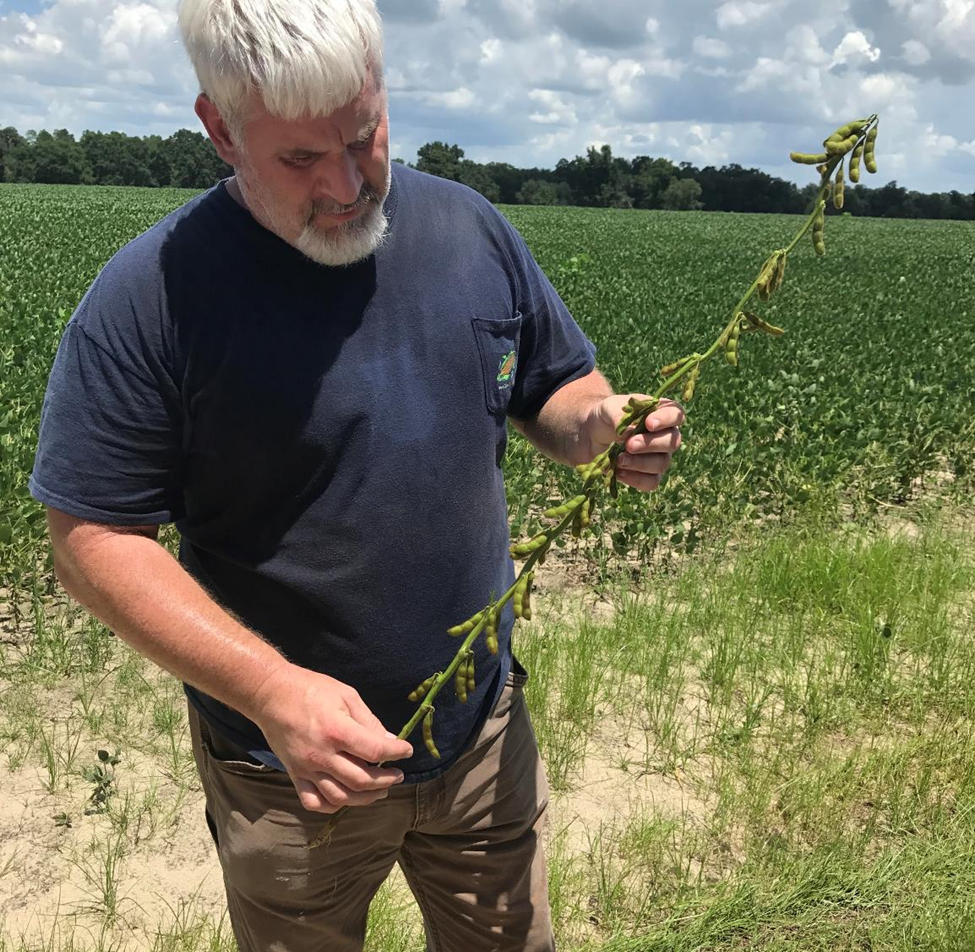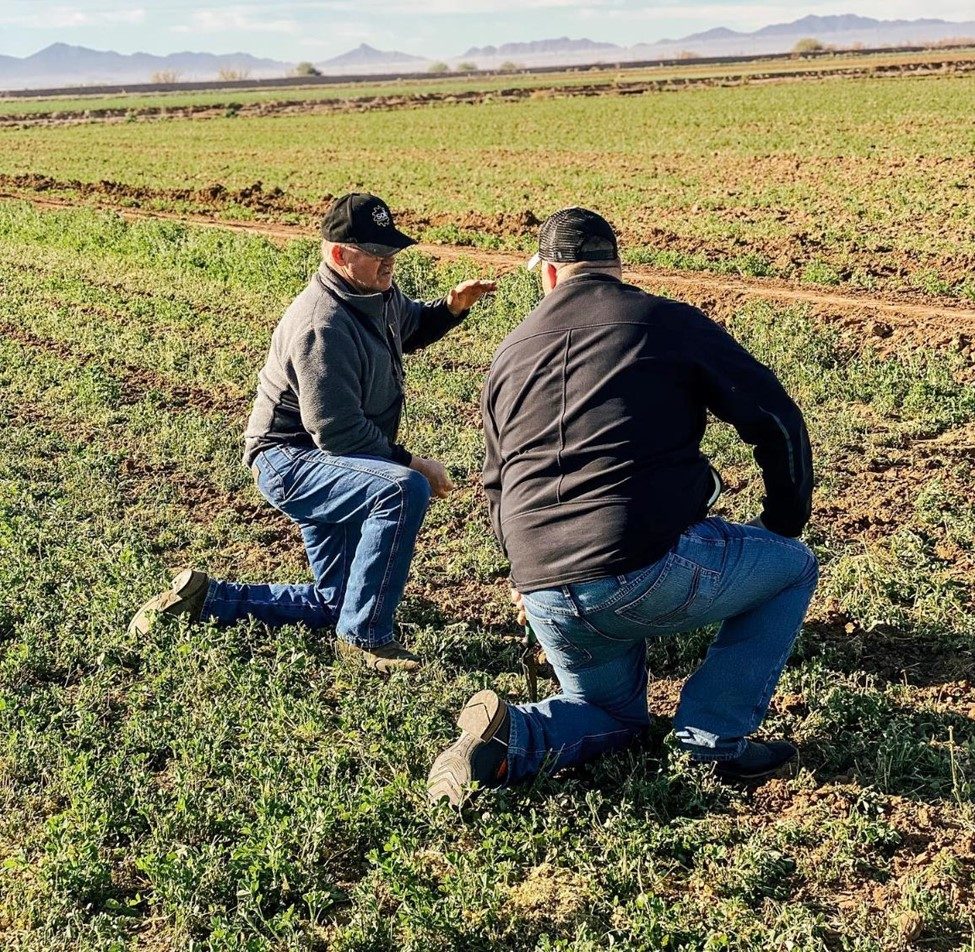David Hula and Randy Dowdy know how to grow a high-yielding crop. The two no-tillers are the reigning corn and soybean yield world record holders, respectively. Hula grew a 616-bushel corn crop on his farm in Charles City, Va., while Dowdy raised 190 bushels of soybeans in Valdosta, Ga.
But outside of their winning plots, the two aren’t only focused on how to maximize yields — they care more about maximizing their profits. An important part of maximizing profits is being what they call “a student of the crop.”
At the 2023 National No-Tillage Conference, Hula and Dowdy shared four ways no-tillers can be a student of their crops, so they can learn from their fields and make more profitable decisions in the future.

STUDYING THE CROP. Soybean yield record holder Randy Dowdy says that growers need to get out of their cabs and into their fields to understand what’s going on and determine what’s working and what’s not. He and David Hula advise taking tissue samples, photos and soil samples throughout the season.
1. Write Down Everything
The first thing someone told Dowdy when he grew his first high-yielding crop was, “Anybody can do it once. Now duplicate it.”
The only way to duplicate something is to know exactly what you did the first time. That's why Dowdy takes note of everything he does, which includes:
- What seed he planted and when he planted it
- Planter vacuum pressure
- Row population and pattern
- What he sprayed and when he sprayed it
- How many gallons of water went out with his herbicides, insecticides and fungicides, and the pH of that water
- How many growing degree units (GDUs) had accumulated by the time he made an application
- Moisture of the crops when he harvested them
“I wrote down everything that I did and if I liked the results, that was going to be my roadmap for the future,” Dowdy says. “You need to understand where yield is captured and where yield is lost, and which ones of those are within your control.”
Hula points out the importance of tracking GDUs instead of growth stages because it’s easy to miscount a leaf.
“I find myself going back into the ’90s because now I can correlate it all to GDUs,” he says.
2. Determine What Pays
“Your local retailer sells a lot of products,” Dowdy says. “Which ones of them pay, not because they say they pay, but because they pay on your farm?”
Dowdy and Hula say no-tillers need to avoid taking someone’s word for whether a product will pay off and determine it for themselves. That means testing it through on-farm trials.
Hula says the big mistake he sees no-tillers make when testing a product is skipping the control. Maybe they got the product for free and inputs are high, he says, so they do the whole field and have nothing to check against the results.
“It’s a pain to leave a control, it truly is,” he says. “I even struggle with it sometimes. We do so many trials, sometimes we forget what we did, and then we see a yield bump or something go down, and we’re like, ‘What happened?’ Then we have to go back and source it. You’ve got to have those controls.”
3. Get Out of the Cab
One of the most effective ways of being a student of the crop is to actually examine the crop. That means going into the fields and collecting data on-site.
On Hula’s farm, they have a protocol of pulling tissue samples every week. Dowdy points out that tissue sampling is one way of ensuring that a fertilizer application is paying off.
“You bought fertilizer, you made a foliar application,” he says. “Why wouldn’t you test to see if the plants responded to those applications? Why wouldn’t you make sure the plant has what you think it should or what somebody thinks it should have for the yield goal you’re trying to make?”
Dowdy also makes a point of stopping the combine during harvest to take pictures, look at ear height uniformities and pull soil samples, especially if there’s a spot in the field that’s doing better than the rest. When that happens, he tries to figure out what he did differently there than the rest of the field.
4. Do the Flag Test
Dowdy once heard the late Steve Albrecht, another yield champion, talk about how his plants all emerged in 8 hours. This inspired him to see how uniformly his plants were emerging and how much of a deviation there could be from the first emerged plant to the last emerged plant without it costing yield. He determines this by doing the flag test.
The concept of the flag test is to flag a plant once it emerges — meaning once you see a corn plant coming out of the ground, when it’s no taller than ⅛ of an inch, you flag it. Then you come back 12 hours later with a different flag color and start flagging every plant that wasn’t there before. Do this every 12 hours until all of the plants you’re expecting have been flagged. Write down how many plants emerged at every interval.
Dowdy recommends working on one-thousandth of an acre, which is 17½ feet down the row for a 30-inch row spacing. The number of plants you should expect to emerge will then be one-thousandth of your plant population. So if your corn population is 31,000 per acre, then you should expect to find 31 plants in that 17½ feet.
Then come back in the fall and hand harvest those plants when the corn is at 30% moisture, putting the ears in separate buckets based on when they emerged. So all the ears from the plants first to emerge are in one bucket, the ones that emerged 12 hours later in another, and so on.
Now you can weigh those buckets and see how much delayed emergence is costing you in yield and start evaluating what you may need to change to make those plants emerge uniformly. Dowdy says the reason Albrecht’s corn emerged so quickly and uniformly is that he waited until his soils were pretty warm.
5. Share What You Learn
Finally, no-tillers can be a student of the crop by learning from others and being willing to share what they’ve learned.
Dowdy and Hula readily share information with each other and other farmers. Hula says that if your growing season dates are different enough, you can even learn from another grower within that season.
“Wouldn’t it be neat to be working with somebody, that might be planting corn March 1, and if it worked, if it influenced that emergence or they saw something in tissue levels, they got 2 months ahead of you, you can exchange that information?” he says. “Wouldn’t that be valuable to somebody?”
Dowdy adds farmers have to break the paradigm of not sharing what they’ve learned with others.
“There’s nothing wrong with building a network of trust and sharing information with one another about what works and what doesn’t work because all of us, David and myself included, still have more to learn,” Dowdy says. “We shouldn’t have to be learning this all by ourselves.”
Catch a Problem Before You Plant Everything
No-tillers don’t harvest their whole crop in 7 days, so Randy Dowdy doesn’t think it makes sense to try to plant everything in seven days either.
Especially if it means getting all your planting done before the crop has emerged. That makes it impossible to catch any planting problems that could be avoided on other fields.
“You will race to get finished,” Dowdy says. “It’s not a race to get finished, it’s a race to get it done correctly. Wouldn’t it be nice to catch a problem so that all of your acres don’t have a problem?”








Post a comment
Report Abusive Comment